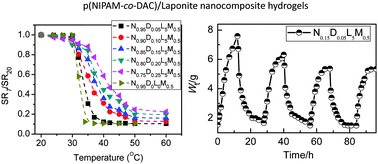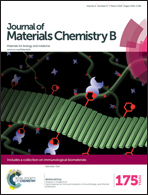Multi-responsive nanocomposite hydrogels with high strength and toughness†
Abstract
Multi-responsive hydrogels with high strength have great significance for potential applications in smart soft devices. However, it remains a challenge to incorporate multiple responsive moieties with energy dissipation mechanisms. Herein, multi-responsive nanocomposite hydrogels with high compressive strength and toughness were synthesized via in situ copolymerization of N-isopropylacrylamide (NIPAM) and acryloyloxyethyltrimethyl ammonium chloride (DAC) in an aqueous dispersion of exfoliated LAPONITE® RDS with a minute amount of N,N′-methylenebisacrylamide (MBAA) as a crosslinker. The combined use of clay and MBAA is demonstrated to be favorable for the high strength and toughness, and helped in avoiding precipitation of clay nanosheets, which otherwise occurred upon addition of cationic DAC. The effect of the NIPAM/DAC molar ratio, MBAA and clay contents on the properties of the hydrogels has been systematically investigated. Compression tests showed a compressive strength up to 6.2 MPa, with fracture strain higher than 90%. The presence of ionic DAC moieties in the hydrogels rendered a very high swelling ratio up to 40 (g g−1). These hydrogels were responsive to temperature changes due to the presence of NIPAM units, with the transition temperature (Ttrans) dependent on the molar ratio of NIPAM and DAC monomers. The internal electrostatic repulsion of the NIPAM/DAC copolymer network changed upon exposure to solutions with different pH and/or ion strength. Cyclic swelling–shrinking was demonstrated by shuttling the gels between pure water and 0.1 mol L−1 NaCl solution.



 Please wait while we load your content...
Please wait while we load your content...